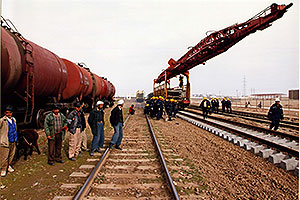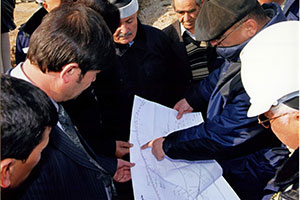U.S. Ambassador Karl Eikenberry joined the president of the Asian Development Bank (ADB), Minister of Finance, Minister of Mines, Minister of Transportation and Civil Aviation, and fellow Ambassadors from Japan, Finland, and Uzbekistan at a ribbon-cutting ceremony inaugurating the Hairatan Rail Line. Hairatan is located in the Balk Provience. This rail link is the first phase of a larger rail network planned for the country, including links to Herat, Tajikistan and Pakistan, and improves connectivity and increase trade throughout the region, supporting growth and cutting poverty.
Source: American Embassy Kabul on Flickr
May 25, 2010: U.S. Ambassador Karl Eikenberry Remarks at Hairatan Rail Line Ceremony
On May 25, U.S. Ambassador Karl Eikenberry joined the president of the Asian Development Bank (ADB), Minister of Finance, Minister of Mines, Minister of Transportation and Civil Aviation, and fellow Ambassadors from Japan, Finland, and Uzbekistan at a ribbon-cutting ceremony inaugurating the Hairatan Rail Line. The United States and Japan are the two largest shareholders in ADB. An ADB grant supports the construction of a 75 km railway line between Hairatan, on the border with Uzbekistan, and Mazar-e-Sharif, Afghanistan’s second largest commercial center. The project will also upgrade Hairatan station yard, build a transshipment terminal, and prepare a railway sector plan. ADB’s grant covers 97% of the total project cost of $170 million, with the Government contributing $5 million. This rail link is the first phase of a larger rail network planned for the country, including links to Herat, Tajikistan and Pakistan, and improves connectivity and increase trade throughout the region, supporting growth and cutting poverty. The new rail line will help remove the major physical bottlenecks that have formed at the border, thereby quadrupling capacity and boosting regional trade.
The Ambassador’s remark’s at the ceremony inaugurating the rail line follow:
Remarks to ADB Ceremony Audience
• Thank you Governor Atta, President Kuroda, and Ministers Zakhilwal and Shahrani.
• The United States and Japan are the two largest shareholders in the Asian Development Bank. We, along with other ADB member nations represented here today have followed this Hairatan Rail Project grant funding closely from its genesis and have supported it strongly via our representation on the ADB’s Board of Directors.
• I am very pleased to see the project reach this point, with construction begun and an end-date planned in advance of the December 2010 completion target. It is my sincere hope to return to Balkh province with President Karzai and others on this stage soon to celebrate the completion of this signature infrastructure project.
• The United States, the ADB, and other members of the international donor community recognized early on that the rehabilitation and expansion of Afghanistan’s transportation infrastructure — roads, airports, and now rail – were a vital component of the Afghan National Development Strategy.
• ADB President Kuroda and others have spoken to you about the economic opportunity and promise that this project offers to Balkh province, to Afghanistan’s northern region, and to the nation as a whole. This is true and very important.
• Following the successful efforts of the Afghan Government, in cooperation with international donor community and international investors, to rebuild other key components of Afghanistan’s basic infrastructure — including the North East Power System, all but a small remaining portion of the Ring Road, and the nation’s world-class telecommunications infrastructure — what the project represents to me is yet another affirmation that large and complex infrastructure projects supported by Afghanistan’s national and provincial governments can be successfully planned and executed. This is part of the process of restoring peace and prosperity to this great Nation.
• In addition to these critical infrastructure projects, the U.S. Embassy has plans to deploy mentors to the Mazar, who will mentor at both the EU customs facility in Haraitan and the Inland Customs Depot. At the request of the Customs Director of Sher Khan Bandar, our Border Management Task Force has began the process of acquiring land at Sher Khan Bandar (SKB), to facilitate deployment of mentors at the Kunduz Inland Customs Depot, and the SKB Border Crossing Point.
• The promise that this Hairatan rail link can be extended east to Kunduz and west to Herat offers hope to visionaries like Minister Zakhiwal and Minister Shahrani — and to all Afghan citizens — that Afghanistan can once again resume its place as a Silk Road crossroads and regional transportation hub. This is all reason celebrate this important day.
Source: Embassy of the United States, Kabul, Afghanistan 2010-05-25


